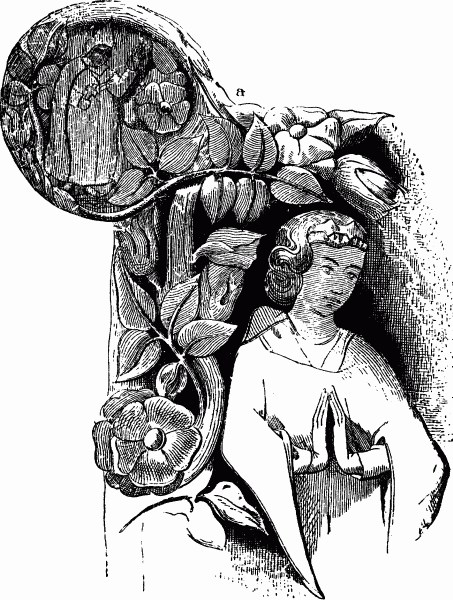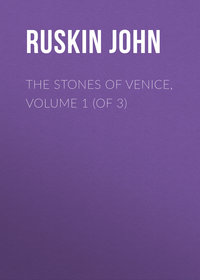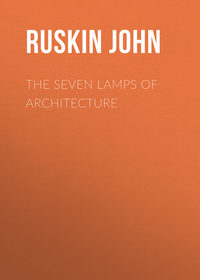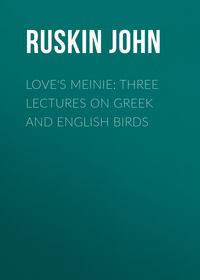 полная версия
полная версияLectures on Architecture and Painting, Delivered at Edinburgh in November 1853
35. But this is a very slight waste of money, compared to the constant habit of putting careful sculpture at the tops of houses. A temple of luxury has just been built in London for the Army and Navy Club. It cost £40,000, exclusive of purchase of ground. It has upon it an enormous quantity of sculpture, representing the gentlemen of the navy as little boys riding upon dolphins, and the gentlemen of the army—I couldn't see as what—nor can anybody; for all this sculpture is put up at the top of the house, where the gutter should be, under the cornice. I know that this was a Greek way of doing things. I can't help it; that does not make it a wise one. Greeks might be willing to pay for what they couldn't see, but Scotchmen and Englishmen shouldn't.
36. Not that the Greeks threw their work away as we do. As far as I know Greek buildings, their ornamentation, though often bad, is always bold enough and large enough to be visible in its place. It is not putting ornament high that is wrong; but it is cutting it too fine to be seen, wherever it is. This is the great modern mistake: you are actually at twice the cost which would produce an impressive ornament, to produce a contemptible one; you increase the price of your buildings by one-half, in order to mince their decoration into invisibility. Walk through your streets, and try to make out the ornaments on the upper parts of your fine buildings—(there are none at the bottoms of them). Don't do it long, or you will all come home with inflamed eyes, but you will soon discover that you can see nothing but confusion in ornaments that have cost you ten or twelve shillings a foot.

Fig. 13.

Fig. 14.
Plate VIII.
37. Now, the Gothic builders placed their decoration on a precisely contrary principle, and on the only rational principle. All their best and most delicate work they put on the foundation of the building, close to the spectator, and on the upper parts of the walls they put ornaments large, bold, and capable of being plainly seen at the necessary distance. A single example will enable you to understand this method of adaptation perfectly. The lower part of the façade of the cathedral of Lyons, built either late in the thirteenth or early in the fourteenth century, is decorated with a series of niches, filled by statues of considerable size, which are supported upon pedestals within about eight feet of the ground. In general, pedestals of this kind are supported on some projecting portion of the basement; but at Lyons, owing to other arrangements of the architecture into which I have no time to enter, they are merely projecting tablets, or flat-bottomed brackets of stone, projecting from the wall. Each bracket is about a foot and a half square, and is shaped thus (fig. 13), showing to the spectator, as he walks beneath, the flat bottom of each bracket, quite in the shade, but within a couple of feet of the eye, and lighted by the reflected light from the pavement. The whole of the surface of the wall round the great entrance is covered with bas-relief, as a matter of course; but the architect appears to have been jealous of the smallest space which was well within the range of sight; and the bottom of every bracket is decorated also—nor that slightly, but decorated with no fewer than six figures each, besides a flower border, in a space, as I said, not quite a foot and a half square. The shape of the field to be decorated being a kind of quatre-foil, as shown in fig. 13, four small figures are placed, one in each foil, and two larger ones in the center. I had only time, in passing through the town, to make a drawing of one of the angles of these pedestals; that sketch I have enlarged, in order that you may have some idea of the character of the sculpture. Here is the enlargement of it (fig. 15). Now observe, this is one of the angles of the bottom of a pedestal, not two feet broad, on the outside of a Gothic building; it contains only one of the four little figures which form those angles; and it shows you the head only of one of the larger figures in the center. Yet just observe how much design, how much wonderful composition, there is in this mere fragment of a building of the great times; a fragment, literally no larger than a school-boy could strike off in wantonness with a stick: and yet I cannot tell you how much care has been spent—not so much on the execution, for it does not take much trouble to execute well on so small a scale—but on the design, of this minute fragment. You see it is composed of a branch of wild roses, which switches round at the angle, embracing the minute figure of the bishop, and terminates in a spray reaching nearly to the head of the large figure. You will observe how beautifully that figure is thus pointed to by the spray of rose, and how all the leaves around it in the same manner are subservient to the grace of its action. Look, if I hide one line, or one rosebud, how the whole is injured, and how much there is to study in the detail of it. Look at this little diamond crown, with a lock of the hair escaping from beneath it; and at the beautiful way in which the tiny leaf at a, is set in the angle to prevent its harshness; and having examined this well, consider what a treasure of thought there is in a cathedral front, a hundred feet wide, every inch of which is wrought with sculpture like this! And every front of our thirteenth century cathedrals is inwrought with sculpture of this quality! And yet you quietly allow yourselves to be told that the men who thus wrought were barbarians, and that your architects are wiser and better in covering your walls with sculpture of this kind (fig. 14, Plate VIII.)

Fig. 15.
PLATE IX.

Fig. 16.
PLATE X.
38. Walk round your Edinburgh buildings, and look at the height of your eye, what you will get from them. Nothing but square-cut stone—square-cut stone—a wilderness of square-cut stone forever and forever; so that your houses look like prisons, and truly are so; for the worst feature of Greek architecture is, indeed, not its costliness, but its tyranny. These square stones are not prisons of the body, but graves of the soul; for the very men who could do sculpture like this of Lyons for you are here! still here, in your despised workmen: the race has not degenerated, it is you who have bound them down, and buried them beneath your Greek stones. There would be a resurrection of them, as of renewed souls, if you would only lift the weight of these weary walls from off their hearts.17
39. But I am leaving the point immediately in question, which, you will remember, was the proper adaptation of ornament to its distance from the eye. I have given you one example of Gothic ornament, meant to be seen close; now let me give you one of Gothic ornament intended to be seen far off. Here (fig. 16) is a sketch of a niche at Amiens Cathedral, some fifty or sixty feet high on the façade, and seven or eight feet wide. Now observe, in the ornament close to the eye, you had six figures and a whole wreath of roses in the space of a foot and a half square; but in the ornament sixty feet from the eye, you have now only ten or twelve large leaves in a space of eight feet square! and note also that now there is no attempt whatsoever at the refinement of line and finish of edge which there was in the other example. The sculptor knew that, at the height of this niche, people would not attend to the delicate lines, and that the broad shadows would catch the eye instead. He has therefore left, as you see, rude square edges to his niche, and carved his leaves as massively and broadly as possible: and yet, observe how dexterously he has given you a sense of delicacy and minuteness in the work, by mingling these small leaves among the large ones. I made this sketch from a photograph, and the spot in which these leaves occurred was obscure; I have, therefore, used those of the Oxalis acetosella, of which the quaint form is always interesting.
40. And you see by this example also what I meant just now by saying, that our own ornament was not only wrongly placed, but wrongly FINISHED. The very qualities which fit this leaf-decoration for due effect upon the eye, are those which would conduce to economy in its execution. A more expensive ornament would be less effective; and it is the very price we pay for finishing our decorations which spoils our architecture. And the curious thing is, that while you all appreciate, and that far too highly, what is called "the bold style" in painting, you cannot appreciate it in sculpture. You like a hurried, broad, dashing manner of execution in a water-color drawing, though that may be seen as near as you choose, and yet you refuse to admit the nobleness of a bold, simple, and dashing stroke of the chisel in work which is to be seen forty fathoms off. Be assured that "handling" is as great a thing in marble as in paint, and that the power of producing a masterly effect with few touches is as essential in an architect as in a draughtsman; though indeed that power is never perfectly attained except by those who possess the power of giving the highest finish when there is occasion.
41. But there is yet another and a weightier charge to be brought against our modern Pseudo-Greek ornamentation. It is, first, wrongly placed; secondly, wrongly finished; and, thirdly, utterly without meaning. Observe in these two Gothic ornaments, and in every other ornament that ever was carved in the great Gothic times, there is a definite aim at the representation of some natural object. In fig. 15 you have an exquisite group of rose-stems, with the flowers and buds; in fig. 16, various wild weeds, especially the Geranium pratense; in every case you have an approximation to a natural form, and an unceasing variety of suggestion. But how much of Nature have you in your Greek buildings? I will show you, taking for an example the best you have lately built; and, in doing so, I trust that nothing that I say will be thought to have any personal purpose, and that the architect of the building in question will forgive me; for it is just because it is a good example of the style that I think it more fair to use it for an example. If the building were a bad one of the kind, it would not be a fair instance; and I hope, therefore, that in speaking of the institution on the Mound, just in progress, I shall be understood as meaning rather a compliment to its architect than otherwise. It is not his fault that we force him to build in the Greek manner.
42. Now, according to the orthodox practice in modern architecture, the most delicate and minute pieces of sculpture on that building are at the very top of it, just under its gutter. You cannot see them in a dark day, and perhaps may never, to this hour, have noticed them at all. But there they are: sixty-six finished heads of lions, all exactly the same; and, therefore, I suppose, executed on some noble Greek type, too noble to allow any modest Modern to think of improving upon it. But whether executed on a Greek type or no, it is to be presumed that, as there are sixty-six of them alike, and on so important a building as that which is to contain your school of design, and which is the principal example of the Athenian style in modern Athens, there must be something especially admirable in them, and deserving your most attentive contemplation. In order, therefore, that you might have a fair opportunity of estimating their beauty, I was desirous of getting a sketch of a real lion's head to compare with them, and my friend Mr. Millais kindly offered to draw both the one and the other for me. You have not, however, at present, a lion in your zoological collection; and it being, as you are probably aware, the first principle of Pre-Raphaelitism, as well as essential to my object in the present instance, that no drawing should be made except from Nature itself, I was obliged to be content with a tiger's head, which, however, will answer my purpose just as well, in enabling you to compare a piece of true, faithful, and natural work with modern architectural sculpture. Here, in the first place, is Mr. Millais' drawing from the living beast (fig. 17, frontispiece). I have not the least fear but that you will at once acknowledge its truth and feel its power. Prepare yourselves next for the Grecian sublimity of the ideal beast, from the cornice of your schools of design. Behold it (fig. 18).
43. Now we call ourselves civilized and refined in matters of art, but I assure you it is seldom that, in the very basest and coarsest grotesques of the inferior Gothic workmen, anything so contemptible as this head can be ever found. They only sink into such a failure accidentally, and in a single instance; and we, in our civilization, repeat this noble piece of work threescore and six times over, as not being able to invent anything else so good! Do not think Mr. Millais has caricatured it. It is drawn with the strictest fidelity; photograph one of the heads to-morrow, and you will find the photograph tell you the same tale. Neither imagine that this is an unusual example of modern work. Your banks and public offices are covered with ideal lions' heads in every direction, and you will find them all just as bad as this. And, farther, note that the admission of such barbarous types of sculpture is not merely ridiculous; it is seriously harmful to your powers of perceiving truth or beauty of any kind or at any time. Imagine the effect on the minds of your children of having such representations of a lion's head as this thrust upon them perpetually; and consider what a different effect might be produced upon them if, instead of this barren and insipid absurdity, every boss on your buildings were, according to the workman's best ability, a faithful rendering of the form of some existing animal, so that all their walls were so many pages of natural history. And, finally, consider the difference, with respect to the mind of the workman himself, between being kept all his life carving, by sixties, and forties, and thirties, repetitions of one false and futile model,—and being sent, for every piece of work he had to execute, to make a stern and faithful study from some living creature of God.

Fig. 17.

Fig. 18.
Plate XI.
44. And this last consideration enables me to press this subject on you on far higher grounds than I have done yet.
I have hitherto appealed only to your national pride, or to your common sense; but surely I should treat a Scottish audience with indignity if I appealed not finally to something higher than either of them,—to their religious principles.
You know how often it is difficult to be wisely charitable, to do good without multiplying the sources of evil. You know that to give alms is nothing unless you give thought also; and that therefore it is written, not "blessed is he that feedeth the poor," but, "blessed is he that considereth the poor." And you know that a little thought and a little kindness are often worth more than a great deal of money.
45. Now this charity of thought is not merely to be exercised towards the poor; it is to be exercised towards all men. There is assuredly no action of our social life, however unimportant, which, by kindly thought, may not be made to have a beneficial influence upon others; and it is impossible to spend the smallest sum of money, for any not absolutely necessary purpose, without a grave responsibility attaching to the manner of spending it. The object we ourselves covet may, indeed, be desirable and harmless, so far as we are concerned, but the providing us with it may, perhaps, be a very prejudicial occupation to some one else. And then it becomes instantly a moral question, whether we are to indulge ourselves or not. Whatever we wish to buy, we ought first to consider not only if the thing be fit for us, but if the manufacture of it be a wholesome and happy one; and if, on the whole, the sum we are going to spend will do as much good spent in this way as it would if spent in any other way. It may be said that we have not time to consider all this before we make a purchase. But no time could be spent in a more important duty; and God never imposes a duty without giving the time to do it. Let us, however, only acknowledge the principle;—once make up your mind to allow the consideration of the effect of your purchases to regulate the kind of your purchase, and you will soon easily find grounds enough to decide upon. The plea of ignorance will never take away our responsibilities. It is written, "If thou sayest, Behold, we knew it not; doth not He that pondereth the heart consider it? and He that keepeth thy soul, doth not He know it?"
46. I could press this on you at length, but I hasten to apply the principle to the subject of art. I will do so broadly at first, and then come to architecture. Enormous sums are spent annually by this country in what is called patronage of art, but in what is for the most part merely buying what strikes our fancies. True and judicious patronage there is indeed; many a work of art is bought by those who do not care for its possession, to assist the struggling artist, or relieve the unsuccessful one. But for the most part, I fear we are too much in the habit of buying simply what we like best, wholly irrespective of any good to be done, either to the artist or to the schools of the country. Now let us remember, that every farthing we spend on objects of art has influence over men's minds and spirits, far more than over their bodies. By the purchase of every print which hangs on your walls, of every cup out of which you drink, and every table off which you eat your bread, you are educating a mass of men in one way or another. You are either employing them healthily or unwholesomely; you are making them lead happy or unhappy lives; you are leading them to look at Nature, and to love her—to think, to feel, to enjoy,—or you are blinding them to Nature, and keeping them bound, like beasts of burden, in mechanical and monotonous employments. We shall all be asked one day, why we did not think more of this.
47. "Well, but," you will say, "how can we decide what we ought to buy, but by our likings? You would not have us buy what we don't like?" No, but I would have you thoroughly sure that there is an absolute right and wrong in all art, and try to find out the right, and like that; and, secondly, sometimes to sacrifice a careless preference or fancy, to what you know is for the good of your fellow-creatures. For instance, when you spend a guinea upon an engraving, what have you done? You have paid a man for a certain number of hours to sit at a dirty table, in a dirty room, inhaling the fumes of nitric acid, stooping over a steel plate, on which, by the help of a magnifying glass, he is, one by one, laboriously cutting out certain notches and scratches, of which the effect is to be the copy of another man's work. You cannot suppose you have done a very charitable thing in this! On the other hand, whenever you buy a small water-color drawing, you have employed a man happily and healthily, working in a clean room (if he likes), or more probably still, out in the pure country and fresh air, thinking about something, and learning something every moment; not straining his eyesight, nor breaking his back, but working in ease and happiness. Therefore if you can like a modest water-color better than an elaborate engraving, do. There may indeed be engravings which are worth the suffering it costs to produce them; but at all events, engravings of public dinners and laying of foundation-stones, and such things, might be dispensed with. The engraving ought to be a first-rate picture of a first-rate subject to be worth buying.
48. Farther, I know that many conscientious persons are desirous of encouraging art, but feel at the same time that their judgment is not certain enough to secure their choice of the best kind of art. To such persons I would now especially address myself, fully admitting the greatness of their difficulty. It is not an easy thing to acquire a knowledge of painting; and it is by no means a desirable thing to encourage bad painting. One bad painter makes another, and one bad painting will often spoil a great many healthy judgments. I could name popular painters now living, who have retarded the taste of their generation by twenty years. Unless, therefore, we are certain not merely that we like a painting, but that we are right in liking it, we should never buy it. For there is one way of spending money which is perfectly safe, and in which we may be absolutely sure of doing good. I mean, by paying for simple sculpture of natural objects, chiefly flowers and animals. You are aware that the possibilities of error in sculpture are much less than in painting; it is altogether an easier and simpler art, invariably attaining perfection long before painting, in the progress of a national mind. It may indeed be corrupted by false taste, or thrown into erroneous forms; but for the most part, the feebleness of a sculptor is shown in imperfection and rudeness, rather than in definite error. He does not reach the fineness of the forms of Nature; but he approaches them truly up to a certain point, or, if not so, at all events an honest effort will continually improve him: so that if we set a simple natural form before him, and tell him to copy it, we are sure we have given him a wholesome and useful piece of education; but if we told him to paint it, he might, with all the honesty in the world, paint it wrongly and falsely, to the end of his days.
49. So much for the workman. But the workman is not the only person concerned. Observe farther, that when you buy a print, the enjoyment of it is confined to yourself and to your friends. But if you carve a piece of stone, and put it on the outside of your house, it will give pleasure to every person who passes along the street—to an innumerable multitude, instead of a few.
Nay, but, you say, we ourselves shall not be benefited by the sculpture on the outsides of our houses. Yes, you will, and in an extraordinary degree; for, observe farther, that architecture differs from painting peculiarly in being an art of accumulation. The prints bought by your friends, and hung up in their houses, have no collateral effect with yours: they must be separately examined, and if ever they were hung side by side, they would rather injure than assist each other's effect. But the sculpture on your friend's house unites in effect with that on your own. The two houses form one grand mass—far grander than either separately; much more if a third be added—and a fourth; much more if the whole street—if the whole city—join in the solemn harmony of sculpture. Your separate possessions of pictures and prints are to you as if you sang pieces of music with your single voices in your own houses. But your architecture would be as if you all sang together in one mighty choir. In the separate picture, it is rare that there exists any very high source of sublime emotion; but the great concerted music of the streets of the city, when turret rises over turret, and casement frowns beyond casement, and tower succeeds to tower along the farthest ridges of the inhabited hills,—this is a sublimity of which you can at present form no conception; and capable, I believe, of exciting almost the deepest emotion that art can ever strike from the bosoms of men.
And justly the deepest: for it is a law of God and of Nature, that your pleasures—as your virtues—shall be enhanced by mutual aid. As, by joining hand in hand, you can sustain each other best, so, hand in hand, you can delight each other best. And there is indeed a charm and sacredness in street architecture which must be wanting even to that of the temple: it is a little thing for men to unite in the forms of a religious service, but it is much for them to unite, like true brethren, in the arts and offices of their daily lives.











